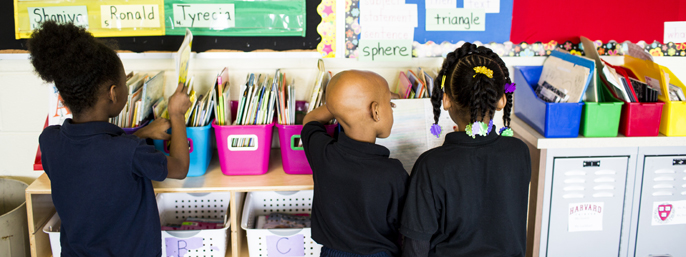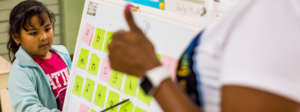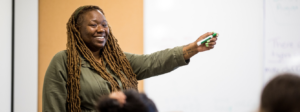We’ve already made the case that it’s important to focus on quality when we talk about expanding pre-K. And we’ve provided some examples of what a great pre-K classroom can look like. But what will it take to actually achieve this at scale, so that every child has access to high-quality early learning opportunities?
As an organization focused on educational opportunities for children in high-poverty communities, it might make sense for us to advocate for quality pre-K only for those kids who need it most. To be clear, we think providing low-income children with high-quality early learning is an urgent matter of social justice. Gaps in educational outcomes between low-income children and their more affluent peers are present as early as 18 months
But with such life-changing outcomes within reach, we can’t choose between quality and universal access: We need both. Without public pre-K for all children, we’ll continue to perpetuate two systems of early learning, separated by income and race—public pre-K for only our lowest-income children, and private pre-K for their more affluent peers. And because most public pre-K programs require families to live far below the federal poverty level (to qualify for Head Start, for example, families must be living at 130 percent of the federal poverty line), families living at or above the poverty line often have no affordable options at all. Plus, research shows that socioeconomically diverse early childhood classrooms have benefits for kids of all backgrounds. It’s difficult to balance the fact that so many kids need better options right now with the realities of the field. As we take early childhood programs to scale, we can’t let their quality slide. As they approach this challenge, states and districts should consider the following: Focus on the neediest kids first. Funding limitations only mean we should prioritize which kids are served first as we work to expand early childhood options. Consider population trends, academic achievement and economic need to determine where new early childhood options can have the most impact. Based on these findings, prioritize creating phased implementation plans to prioritize getting new early childhood programs to the families that need them most, then build toward pre-K for all kids. As we’ve seen in places like Oklahoma and New York City, it is possible to provide universal pre-K when states and districts prioritize it as part of their standard educational obligation to students—much as kindergarten has become widely funded, even though it is still not compulsory in most states. It takes time. After launching Pre-K For All in 2008, Washington, D.C. now enrolls more than 70 percent of its three-year-olds and more than 90 percent of its four-year-olds in public pre-K, through a mix of district-, charter- and community-based programs. Define a clear vision of excellence. Establish a vision for excellent early childhood instruction, and build a reliable tool for assessing whether programs are meeting that bar. In D.C., the Early Childhood Performance Management Framework helps the District ensure that quality is consistent across programs, even as they expand access to more students. Undoubtedly, getting every pre-K classroom to reach a high bar is just as hard as getting every K-12 classroom there—so the same level of attention must be paid to making it happen. Prioritize excellent programs and teachers. Carefully select which programs are awarded new funding by looking at factors such as program leadership, teacher effectiveness and instructional approach. The selection process should include classroom visits to ensure programs are rich, rigorous and developmentally appropriate environments where kids are actively learning. In New York City, nearly half of providers that applied for new pre-K funds were rejected because they did not meet the quality bar. Similar care needs to be afforded to selecting new teachers and leaders. Educators need to be provided with the training they need to be able to build students’ foundational and complex literacy skills, foster conceptual understanding in math and integrate academic, social and emotional skills into a cohesive experience for. We can make sure this training works by looking at kindergarten readiness: If trainings don’t lead to improved outcomes for students, they should be reexamined. Engage with families. New pre-K openings only make a difference if families take advantage of them. Expanding early childhood access needs to be paired with a comprehensive public awareness campaign that lets local families know about the new options and motivates them to take part. In the years leading up to the launch of New York City’s universal pre-K initiative, the district developed partnerships with community organizations, ad campaigns on subways and buses, and resources for families, including interactive maps to help families find the best options for their children. While states have to be strategic about how they dole out funding, the benefits of pre-K in the long run far outweigh the costs. The more children have access to great early learning classrooms—and the more diverse those classrooms are—the better for everyone.








